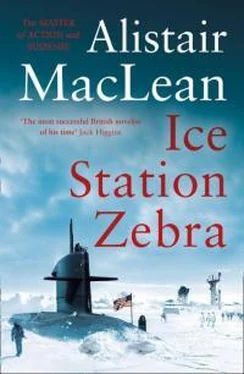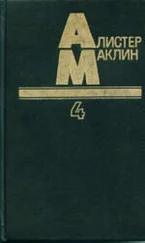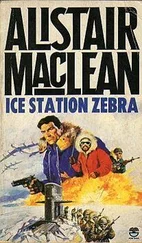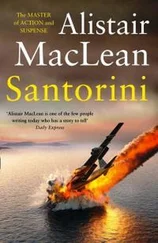‘Is it now?’ Rawlings surveyed the depths of his coffee cup. ‘I wonder how a man gets to be a specialist in those things?’
Hansen stirred and withdrew his gaze from the darkly-white world beyond the canteen windows.
‘Dr Carpenter is not on trial for his life,’ he said mildly. ‘The counsel for the prosecution will kindly pack it in.’
They packed it in. This air of easy familiarity between officer and men, the easy camaraderie, the mutually tolerant disparagement with the deceptively misleading overtones of knock-about comedy, was something very rare in my experience but not unique. I’d seen it before, in first-line R.A.F. bomber crews, a relationship found only among a close-knit, close-living group of superbly trained experts each of whom is keenly aware of their complete interdependence. The casually informal and familiar attitude was a token not of the lack of discipline but of the complete reverse: it was the token of a very high degree of self-discipline, of the regard one man held for another not only as a highly-skilled technician in his own field but also as a human being. It was clear, too, that a list of unwritten rules governed their conduct. Offhand and frequently completely lacking in outward respect though Rawlings and Zabrinski were in their attitude towards Lieutenant Hansen, there was an invisible line of propriety over which it was inconceivable that they would ever step: for Hansen’s part, he scrupulously avoided any use of his authority when making disparaging remarks at the expense of the two enlisted men. It was also clear, as now, who was boss.
Rawlings and Zabrinski stopped questioning me and had just embarked upon an enthusiastic discussion of the demerits of the Holy Loch in particular and Scotland in general as a submarine base when a jeep swept past the canteen windows, the snow whirling whitely, thickly, through the swathe of the headlights. Rawlings jumped to his feet in mid-sentence, then subsided slowly and thoughtfully into his chair.
‘The plot,’ he announced, ‘thickens.’
‘You saw who it was?’ Hansen asked.
‘I did indeed. Andy Bandy, no less.’
‘I didn’t hear that, Rawlings,’ Hansen said coldly.
‘Vice-Admiral John Garvie, United States Navy, sir.’
‘Andy Bandy, eh?’ Hansen said pensively. He grinned at me. ‘Admiral Garvie, Officer Commanding U.S. Naval Forces in Nato. Now this is very interesting, I submit. I wonder what he’s doing here.’
‘World War III has just broken out,’ Rawlings announced. ‘It’s just about time for the Admiral’s first martini of the day and no lesser crisis–’
‘He didn’t by any chance fly down with you in that chopper from Renfrew this afternoon?’ Hansen interrupted shrewdly.
‘No.’
‘Know him, by any chance?’
‘Never even heard of him until now.’
‘Curiouser and curiouser,’ Hansen murmured.
A few minutes passed in desultory talk – the minds of Hansen and his two men were obviously very much on the reason for the arrival of Admiral Garvie – and then a snow-filled gust of chilled air swept into the canteen as the door opened and a blue-coated sailor came in and crossed to our table.
‘The captain’s compliments, Lieutenant. Would you bring Dr Carpenter to his cabin, please?’
Hansen nodded, rose to his feet and led the way outside. The snow was beginning to lie now, the darkness was coming down fast and the wind from the north was bitingly chill. Hansen made for the nearest gangway, halted at its head as he saw seamen and dockyard workers, insubstantial and spectral figures in the swirling flood-lit snow, carefully easing a slung torpedo down the for’ard hatch, turned and headed towards the after gangway. We clambered down and at the foot Hansen said: ‘Watch your step, Doc. It’s a mite slippery hereabouts.’
It was all that, but with the thought of the ice-cold waters of the Holy Loch waiting for me if I put a foot wrong I made no mistake. We passed through the hooped canvas shelter covering the after hatch and dropped down a steep metal ladder into a warm, scrupulously clean and gleaming engine-room packed with a baffling complexity of grey-painted machinery and instrument panels, its every corner brightly illuminated with shadowless fluorescent lighting.
‘Not going to blindfold me, Lieutenant?’ I asked.
‘No need.’ He grinned. ‘If you’re on the up and up, it’s not necessary. If you’re not on the up and up it’s still not necessary, for you can’t talk about what you’ve seen – not to anyone that matters – if you’re going to spend the next few years staring out from behind a set of prison bars.’
I saw his point. I followed him for’ard, our feet soundless on the black rubber decking past the tops of a couple of huge machines readily identifiable as turbo-generator sets for producing electricity. More heavy banks of instruments, a door, then a thirty-foot-long very narrow passageway. As we passed along its length I was conscious of a heavy vibrating hum from beneath my feet. The Dolphin’s nuclear reactor had to be somewhere. This would be it, here. Directly beneath us. There were circular hatches on the passageway deck and those could only be covers for the heavily-leaded glass windows, inspection ports which would provide the nearest and only approach to the nuclear furnace far below.
The end of the passage, another heavily-clipped door, and then we were into what was obviously the control centre of the Dolphin. To the left was a partitioned-off radio room, to the right a battery of machines and dialled panels of incomprehensible purpose, straight ahead a big chart table. Beyond that again, in the centre were massive mast housings and, still farther on, the periscope stand with its twin periscopes. The whole control room was twice the size of any I’d ever seen in a conventional submarine but, even so, every square inch of bulkhead space seemed to be taken up by one type or another of highly-complicated looking machines or instrument banks: even the deckhead was almost invisible, lost to sight above thickly twisted festoons of wires, cables and pipes of a score of different kinds.
The for’ard port side of the control room was for all the world like a replica of the flight-deck of a modern multi-engined jet airliner. There were two separate yoke aircraft-type control columns, facing on to banks of hooded calibrated dials. Behind the yokes were two padded leather chairs, each chair, I could see, fitted with safety-belts to hold the helmsman in place. I wondered vaguely what type of violent manoeuvres the Dolphin might be capable of when such safety-belts were obviously considered essential to strap the helmsman down.
Opposite the control platform, on the other side of the passageway leading forward from the control room, was a second partitioned-off room. There was no indication what this might be and I wasn’t given time to wonder. Hansen hurried down the passage, stopped at the first door on his left, and knocked. The door opened and Commander Swanson appeared.
‘Ah, there you are. Sorry you’ve been kept waiting, Dr Carpenter. We’re sailing at six-thirty, John–’ this to Hansen. ‘You can have everything buttoned up by then?’
‘Depends how quickly the loading of the torpedoes goes, Captain.’
‘We’re taking only six aboard.’
Hansen lifted an eyebrow, made no comment. He said: ‘Loading them into the tubes?’
‘In the racks. They have to be worked on.’
‘No spares?’
‘No spares.’
Hansen nodded and left. Swanson led me into his cabin and closed the door behind him.
Commander Swanson’s cabin was bigger than a telephone booth, I’ll say that for it, but not all that much bigger to shout about. A built-in bunk, a folding washbasin, a small writing-bureau and chair, a folding camp-stool, a locker, some calibrated repeater instrument dials above the bunk and that was it. If you’d tried to perform the twist in there you’d have fractured yourself in a dozen places without ever moving your feet from the centre of the floor.
Читать дальше
Конец ознакомительного отрывка
Купить книгу










